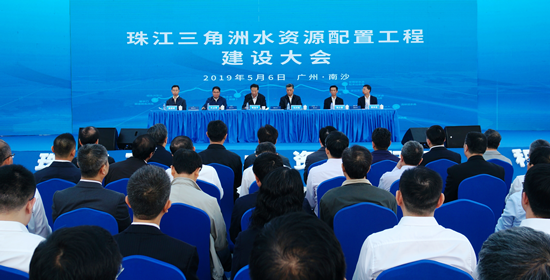Nansha to realize double water source protection

The Pearl River Delta Water Resources Allocation Project, the first major project after the announcement of the Outline Development Plan for the Guangdong-Hong Kong-Macao Greater Bay Area, starts on May 6 in Nansha.

The companies introduce the concrete situation of the project. [Photo/gznsnews.com.cn]
The water transmission line starts from the Shunde section of the Xijiang River in the west, and passes newly built Gaoxinsha Reservoir on its way to Songmushan Reservoir, Shenzhen Luotian Reservoir, and Gongming Reservoir.
The total length of the water transmission line is 113.2 kilometers, of which the trunk line project is 90.3 kilometers.
The Shenzhen branch line project is 11.9 kilometers and the Dongguan branch line project is 3.6 kilometers. The Nansha branch line project is 7.4 kilometers.
The water resources allocation project in the Pearl River Delta is the largest water conservancy project in Guangdong history with the largest investment, the longest water transmission line and the widest water receiving area. It is also the world's largest water transfer project with the highest water pressure and the longest shield tunnel.
After completion it will improve the water supply guarantee rate and water emergency support capability of the Guangdong-Hong Kong- Macao Greater Bay Area.
Yan Zhenrui, deputy chief engineer of the Guangdong Water Resources and Electric Power Survey and Design Institute said,"The project can not only solve the problem of water shortage in Guangzhou, Shenzhen and Dongguan, but also change the status of single water supply in the eastern part of the Greater Bay Area, realizing a dual water source and double guarantee by Dongjiang and Xijiang."
At the same time, it can provide emergency backup water sources for Hong Kong, Guangzhou's Panyu district, Foshan's Shunde district and other places, he added.
The water resources allocation project will also improve the ecological environment in the eastern part of the Greater Bay Area.
According to experts, the highly difficult and risky construction process is all under water.
The water transmission line needs to cross the core urban agglomeration of the Pearl River Delta and the Lions Ocean in the Pearl River estuary. There are 61 villages, 12 railways and subways, 23 expressways and urban expressways, and 16 rivers with a width of 100 meters or more.
"It is necessary to pass through 12 underwater fracture-breaking zones and other unfavorable strata, which may bring various risks, especially the potential dangers caused by high water pressure seepage." Zhang Lei, deputy general manager of the Pearl River Delta Water Resources Allocation Project Department of China Railway Tunnel Bureau pointed out.
MOST POPULAR
- 1 China to give visa-free treatment to another 9 countries
- 2 China fully opens manufacturing sector to foreign investors in landmark opening up move
- 3 China's import expo attracts record-breaking participating countries, exhibitors
- 4 China's door opening even wider to foreign visitors, businesses
- 5 China revises rules to ease foreign strategic investment in listed firms
Editors' Picks
 Video:
Peru sees new port open
Video:
Peru sees new port open
 Infographic:
China's public holidays for 2025
Infographic:
China's public holidays for 2025
 Infographic:
Basic facts of APEC
Infographic:
Basic facts of APEC
 Infographic:
Wrapping up the 7th CIIE: Data recap
Infographic:
Wrapping up the 7th CIIE: Data recap



